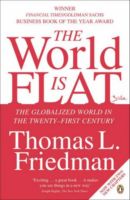In verzameling
#156
Gelezen?:
Ja
Economics, Sociology
#156
Gelezen?:
Ja
Globalization
Overview (From Wikipedia: http://en.wikipedia.org/wiki/The_World_is_Flat )Friedman on a journey to Bangalore, India, realizes that globalization has changed core economic concepts.[1] Due to this discovery, he suggests that the world is "flat" in the sense that the competitive playing fields between industrial and emerging market countries have been leveled. Friedman recounts many examples in which companies in India and China are becoming part of large global complex supply chains. These companies mainly provide service representatives. He recalls seeing American companies such as Dell, AOL, and Microsoft using teleoperators who are paid very low wages.
Friedman lists ten "flatteners" that have leveled the global playing field:
* #1: Collapse of Berlin Wall-11/9: The event not only symbolized the end of the Cold war, it allowed people from other side of the wall to join the economic mainstream. (11/09/1989)
* #2: Netscape: Netscape and the Web broadened the audience for the Internet from its roots as a communications medium used primarily by 'early adopters and geeks' to something that made the Internet accessible to everyone from five-year-olds to eighty-five-year olds. (8/9/1995)
* #3: Workflow software: The ability of machines to talk to other machines with no humans involved. Friedman believes these first three forces have become a “crude foundation of a whole new global platform for collaboration.”
* #4: Open sourcing: Communities uploading and collaborating on online projects. Examples include open source software, blogs, and Wikipedia. Friedman considers the phenomenon "the most disruptive force of all."
* #5: Outsourcing: Friedman argues that outsourcing has allowed companies to split service and manufacturing activities into components, with each component performed in most efficient, cost-effective way.
* #6: Offshoring: The manufacturing version of outsourcing.
* #7: Supply chaining: Friedman compares the modern retail supply chain to a river, and points to Wal-Mart as the best example of a company using technology to streamline item sales, distribution, and shipping.
* #8: Insourcing: Friedman uses UPS as a prime example for insourcing, in which the company's employees perform services--beyond shipping--for another company. For example, UPS itself repairs Toshiba computers on behalf of Toshiba. The work is done at the UPS hub, by UPS employees.
* #9: In-forming: Google and other search engines are the prime example. "Never before in the history of the planet have so many people-on their own-had the ability to find so much information about so many things and about so many other people", writes Friedman.
* #10: "The Steroids": Personal digital equipment like mobile phones, iPods, personal digital assistants, instant messaging, and voice over IP or VOIP.
In addition to Friedman's ten flatteners he also offered the concept of the triple convergence which created a new, flatter, global playing field.
* CONVERGENCE I: Up until the year 2000 the ten flatteners were semi-independent from one another. However around the year 2000, all of the flatteners converged with one another. This convergence could be compared to complementary goods, in that each flattener enhanced all of the other flatteners; the more one flattener developed, the more the global playing field was leveled.
* CONVERGENCE II: After the emergence of the ten flatteners, a new platform had to be built in order to do business. Businesses had to begin collaborating horizontally as opposed to vertically (top down method of collaboration where innovation comes from the top). Horizontalization meant that companies and people had to start collaborating with other departments or companies in order to add value creation or innovation. However, the convergence occurred when horizontalization and the ten flatteners began to reinforce each other.
* CONVERGENCE III: After the fall of the Berlin Wall, countries such as: India, China, Russia, Eastern Europe, Latin America, and Central Asia that followed a Soviet economic plan began to open up their economies to the world. When these new players converged with the rest of the Global playing field, they added new brain power to that field. Therefore, the convergence enhanced horizontal collaboration across the globe. In turn, this convergence was the most important force in shaping politics and economics in the early twenty-first century.
The New Middle The new middle refers to American jobs that cannot be 'outsourced, automated, or digitized.' These jobs include physicians, surgeons, dentists, orthodontists, pharmacists, and trial lawyers. These professionals have a lot of job security.
The Unflat World
Friedman acknowledges there are some 3 billion people in places like rural India, rural China, and Africa who still live in an "unflattened" world.
Beschrijving:
Friedman's boek over de groeiende mogelijkheden voor individuen om op wereldschaal met elkaar te concurreren en samen te werken, leverde veel reacties op. Dat leidde ertoe dat hij een geactualiseerde versie van 'De Aarde is plat' besloot te schrijven. De drie globaliseringstijdperken en de tien krachten die de Aarde platmaakten. blijven gehandhaafd. Friedman wijdt echter nu een nieuw speciaal onderdeel aan wat we nodig hebben om een antwoord te geven op de uitdagingen van de Aarde die plat is: onderwijsinnovatie. Kids moeten aan het werk worden gezet. Eerder sprak hij over een achterstand en nu over een onderwijskloof waar een oplossing voor moet worden gezocht. Waar hij eerst drie pijnlijke feiten schetste, constateert hij er nu zes en bewogen plattisme wordt nu zorgzaam plattisme. In plaats van zes terreinen van aanpak voor het tijdperk van globalisering worden nu vijf fundamentele gebieden beschreven. In een platte wereld kan men alleen gedijen door het volgende nieuwe ding uit te vinden. Friedmans gloedvol betoog dient ter harte te worden genomen. Uploading maakt de globalisering van het 'lokale' mogelijk dankzij internet. Een boek dat ook door anti-globalisten dient te worden gelezen.
|
|
||||||||||||||
Opmerkingen
Versie 3.0
